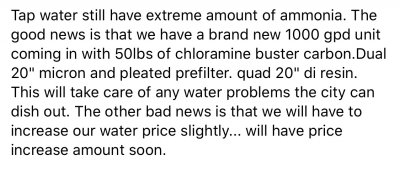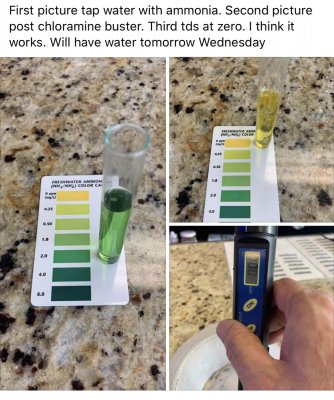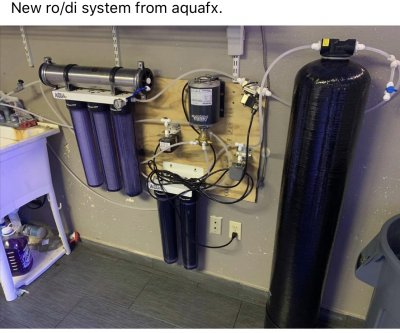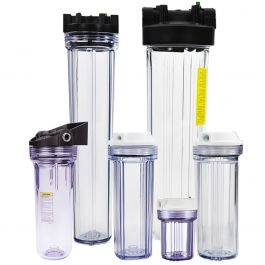Lol yes well I sure hope so!Might be channeling. Are you sure it is oriented with the proper side up?
Navigation
Install the app
How to install the app on iOS
Follow along with the video below to see how to install our site as a web app on your home screen.
Note: This feature may not be available in some browsers.
More options
You are using an out of date browser. It may not display this or other websites correctly.
You should upgrade or use an alternative browser.
You should upgrade or use an alternative browser.
Chloramines
- Thread starter Thespammailaccount
- Start date
- Tagged users None
- Joined
- Nov 8, 2019
- Messages
- 100
- Reaction score
- 92
My city also uses chloramines for treatment and I’m watching this thread closely. I’m planning on the BRS 7 stage, using the right carbons and throwing in the chloramine monster for good measure.
I know must RO/DI setups are the same quality and probably come out of the same factories.
Are there any better setups than the BRS 7 stage + chloramine monster or is this considered to be the best?
I know must RO/DI setups are the same quality and probably come out of the same factories.
Are there any better setups than the BRS 7 stage + chloramine monster or is this considered to be the best?
Is your deion resin expired? Does it change color? High co2 in the water will make deion resin die quickly. Like a week or two quickly.
Don’t think the resin was expired. When it started to change color at the bottom I would change them out. Not sure have not tested the water for co2 not sure how to do thatIs your deion resin expired? Does it change color? High co2 in the water will make deion resin die quickly. Like a week or two quickly.
Iirc there are co2 test strips. Not sure thats your problem though. But there are two parts to deion.Don’t think the resin was expired. When it started to change color at the bottom I would change them out. Not sure have not tested the water for co2 not sure how to do that
In a rodi setup the carbon should remove the chlorine and the cation should remove the ammonia?yes, it converts it into ammonia.
how high is your tds prior to the di resins?
Randy Holmes-Farley
Reef Chemist
View Badges
Staff member
Super Moderator
Excellence Award
Expert Contributor
Article Contributor
R2R Research
My Tank Thread
- Joined
- Sep 5, 2014
- Messages
- 67,276
- Reaction score
- 63,622
In a rodi setup the carbon should remove the chlorine and the cation should remove the ammonia?
yes. Ammonia will also be slightly rejected by the ro membrane, as would chloramine that was not broken down.
My setup is as follows; 1.0 pre filter, BRS chloromine monster, membrane, single DI. Rural water supply free and total chlorine before monster 3ppm, after 0 free and 0 total chlorine. My 20" x 4" Chloromine filter is almost two years old and I have 65 and 300 gallon tanks. Before the beast I was going through 10" filters made for chloromines like crazy. I use a 75 gallon a day membrane from BRS and my pressure is barely over 50 psi, and I get almost 75 gallons a day.
- Joined
- Nov 8, 2019
- Messages
- 100
- Reaction score
- 92
Finally got mine up and running. My city uses chloramines for half the year and chlorine for the other half. We also have pretty hard water. My waste line is cloudy!
280 TDS initial reading
263 TDS after pre filter and chloramines monster
6 TDS after BRS 7 Stage 75 GPD
0 TDS after DI
I am running a larger pre filter so I swapped out the BRD pre filter with another carbon block.

280 TDS initial reading
263 TDS after pre filter and chloramines monster
6 TDS after BRS 7 Stage 75 GPD
0 TDS after DI
I am running a larger pre filter so I swapped out the BRD pre filter with another carbon block.
Love the large pre-filter!Finally got mine up and running. My city uses chloramines for half the year and chlorine for the other half. We also have pretty hard water. My waste line is cloudy!
280 TDS initial reading
263 TDS after pre filter and chloramines monster
6 TDS after BRS 7 Stage 75 GPD
0 TDS after DI
I am running a larger pre filter so I swapped out the BRD pre filter with another carbon block.

Last edited:
Randy Holmes-Farley
Reef Chemist
View Badges
Staff member
Super Moderator
Excellence Award
Expert Contributor
Article Contributor
R2R Research
My Tank Thread
- Joined
- Sep 5, 2014
- Messages
- 67,276
- Reaction score
- 63,622
Finally got mine up and running. My city uses chloramines for half the year and chlorine for the other half. We also have pretty hard water. My waste line is cloudy!
280 TDS initial reading
263 TDS after pre filter and chloramines monster
6 TDS after BRS 7 Stage 75 GPD
0 TDS after DI
I am running a larger pre filter so I swapped out the BRD pre filter with another carbon block.

Did you determine that a special chloramine setup was needed, or did you just set up that way?
Have you tested for chloramine in the effluent?
- Joined
- Nov 8, 2019
- Messages
- 100
- Reaction score
- 92
I know from public reports that my city uses chloramines for half the year and I wanted to play it safe in the long run.Did you determine that a special chloramine setup was needed, or did you just set up that way?
Have you tested for chloramine in the effluent?
I’m pretty certain that the BRD 7-Stage would get rid of my level of chloramines for a certain period of time but I felt that having the Monster would alleviate concerns of break through.
I have an ultra low chlorine tester (ppb) that I will periodically check my post RO water with to make sure the filters are still doing their job.
Randy Holmes-Farley
Reef Chemist
View Badges
Staff member
Super Moderator
Excellence Award
Expert Contributor
Article Contributor
R2R Research
My Tank Thread
- Joined
- Sep 5, 2014
- Messages
- 67,276
- Reaction score
- 63,622
I know from public reports that my city uses chloramines for half the year and I wanted to play it safe in the long run.
I’m pretty certain that the BRD 7-Stage would get rid of my level of chloramines for a certain period of time but I felt that having the Monster would alleviate concerns of break through.
I have an ultra low chlorine tester (ppb) that I will periodically check my post RO water with to make sure the filters are still doing their job.
Thanks. I recognize it is fine insurance.
Since my testing of effluent from people's RO/DI for my chloramine article (and not finding that breakthrough is common), I've been skeptical of the need for special equipment in most cases.
But it certainly doesn't hurt.
I have almost the exact setup. 75gpd with triple di and chloramine monster pre rodi. My city uses chloramine year around where 2-4 is the acceptable range. If you want to know if the ammonia from the chloramines is breaking through test your product water for ammoniaI know from public reports that my city uses chloramines for half the year and I wanted to play it safe in the long run.
I’m pretty certain that the BRD 7-Stage would get rid of my level of chloramines for a certain period of time but I felt that having the Monster would alleviate concerns of break through.
I have an ultra low chlorine tester (ppb) that I will periodically check my post RO water with to make sure the filters are still doing their job.
I did not know you wrote an article about chloramines. This is from a well respected LFS in my area. Outliner I supposeThanks. I recognize it is fine insurance.
Since my testing of effluent from people's RO/DI for my chloramine article (and not finding that breakthrough is common), I've been skeptical of the need for special equipment in most cases.
But it certainly doesn't hurt.



- Joined
- Nov 8, 2019
- Messages
- 100
- Reaction score
- 92
Love the large pre-filter!
It was fairly cheap to piece it together and allowed me to add another carbon to the unit. The canister was $39.99 and I had to buy fittings for it and a pre-filter of course.

Reverse Osmosis and Reactor Canisters
We carry a wide variety of reverse osmosis canisters, and depending on your system or reactor we most likely have the canister to fit your needs. The most common RODI systems along with the BRS systems use the 10" Canister with 1/4" ports. The standard and dual BRS Reactors use the same 10"...
- Joined
- Sep 15, 2016
- Messages
- 70
- Reaction score
- 37
I use the Pentek ChlorPlus 20BB (4.5" x 20" big blue style) cartridges and I'm happy with their life expectancy with a water provider using chloramines. I run 2 such blocks in series after a sediment filter and before my RO membranes and DI resin. It's not cheap but it's super convenient and effective.
Edit: AquaFX is great as well. I use their RO membranes and DI resin. I've gone to their shop, in person, a couple of times and they're super helpful. A+ goes to them.
Edit: AquaFX is great as well. I use their RO membranes and DI resin. I've gone to their shop, in person, a couple of times and they're super helpful. A+ goes to them.
Randy Holmes-Farley
Reef Chemist
View Badges
Staff member
Super Moderator
Excellence Award
Expert Contributor
Article Contributor
R2R Research
My Tank Thread
- Joined
- Sep 5, 2014
- Messages
- 67,276
- Reaction score
- 63,622
I cannot disagree with anything they say. The question is whether an ordinary high quality ro/di would accomplish the same thing. their system will certainly work, but it might be overkill.
- Joined
- Sep 20, 2018
- Messages
- 1,117
- Reaction score
- 1,090
My setup is three 10" canisters of catalytic carbon then two Pentek blocks.
When I added a 2nd membrane I had to add a booster pump and suddenly 2-3 carbon stages wasn't enough.
Tested with a Hach DR/900.
When I added a 2nd membrane I had to add a booster pump and suddenly 2-3 carbon stages wasn't enough.
Tested with a Hach DR/900.
Randy Holmes-Farley
Reef Chemist
View Badges
Staff member
Super Moderator
Excellence Award
Expert Contributor
Article Contributor
R2R Research
My Tank Thread
- Joined
- Sep 5, 2014
- Messages
- 67,276
- Reaction score
- 63,622
This is my chloramine article:
from it:
Removing Chloramine With Activated Carbon: Does it Really Work?
There has been much debate over whether commercial RO/DI systems used by aquarists are actually removing chloramine in adequate quantity. The concern is not whether they can theoretically do so, but whether the actual units allow sufficient contact time between the water and the activated carbon for the units to do an adequate job.
I have been using a Spectrapure RO/DI system (CSP25DI) for years, and my water does contain chloramine, so naturally I was interested to know if it was up to the task. In discussing the issue with Charles Mitsis, President of Spectrapure, he said that my water was among the most difficult to successfully remove chloramine from because the pH was high, and he was not sure that the unit was adequate. The reasons for being concerned were that:
Monochloramine is the most difficult of the three chloramine species to remove because it is small (allowing it to pass through a reverse osmosis membrane).
2. Monochloramine is the most chemically stable of the chloramine species, so is the hardest to break down (as on activated carbon).
3. Monochloramine predominates over the other forms in tap water at pH above 7 (dichloramine predominates at pH 4-7).
4. The pores of the activated carbon may become plugged with sediment over time, reducing the effectiveness of the carbon at breaking apart chloramine.
5. At high pH, the pores of the RO membrane can swell, resulting in poorer rejection of impurities.
With this as the backdrop, I set about organizing a round of testing by aquarists to see if their commercially-available systems were adequately removing chloramine.
First, I selected a single, high quality test method for participants to use: the Hach CN-70 kit described above. I then asked aquarists to test several things:
1. The free and total chlorine in their tap water after letting it run for a while.
2. The free and total chlorine in their RO reject water.
3. The free and total chlorine in their finished RO/DI water.
4. The pH of the tap water.
In my case, for example, I had the following results:
Tap water:
pH ~9
Total Chlorine: 0.4-0.5 ppm one day, 0.08 ppm on a second day.
Free chlorine: <0.01 ppm (effectively all of the total chlorine was chloramine)
RO Reject water:
Total Chlorine: 0.02 ppm
Free chlorine: <0.01 ppm
Final RO/DI water:
Total Chlorine: <0.01 ppm
Consequently, within the capabilities of the Hach test kit (0.01 ppm), there is no chloramine getting through the system. A small amount does appear to get past the carbon to the RO waste water, but it does not get through the RO membrane and DI resin.
A similar set of data (more or less complete) was collected from about 20 aquarists in different parts of the country. These included systems that were stated to have a capacity of 25-100 gallons per day, the higher volume systems being especially interesting because the contact time with the carbon might be shorter. All but one had similar results to those reported here. The anomalous report produced the following results:
Tap Water:
pH 8.2
Total Chlorine: >3.5 ppm
Free Chlorine: >3.5 ppm
Filtered Tap Water: (single cartridge under sink, cold water side)
Total Chlorine: 0.7 ppm
Free Chlorine: 0.38 ppm
RO water: (11 month old cartridges)
Total Chlorine: 0.16 ppm
Free Chlorine: 0.06 ppm
RO/DI water: (11 month old cartridges)
Total Chlorine: 0.04 ppm
Free Chlorine: 0.02 ppm
RO/DI water: (Fresh cartridges)
Total Chlorine: <0.01 ppm
Free Chlorine: <0.01 ppm
In short, his tap water chloramine (and chlorine) levels were quite high. His old carbon and sediment cartridges were not quite up to the task, but when replaced, were adequate to remove all of the chloramine. Note that the 11 month old cartridges were still producing 0-1 ppm TDS RO/DI water.
Lessons Learned and Suggestions:
Most RO/DI systems seem capable of removing chloramine adequately for aquarists.
2. The carbon cartridge may become less useful over time, and it is possible that the chloramine removal effectiveness of a system may be lost before the DI appears to need changing.
3. Cheap sediment cartridges may expose the carbon cartridge to unnecessary fouling, which may permit chloramine to pass through the system. Cartridges should be replaced as soon as the pressure drops significantly, even if RO/DI water is still being produced at a reasonable rate or purity as measured by total dissolved solids.
4. Testing for chlorine and chloramine is easy, so any concern is easily reconciled.
5. One Hach kit provides several dozen test results. Our local Boston Club bought some kits and had a "water testing day." The kits can also become part of the "library" of a local club for aquarists to use once in a while to see if their systems are functioning. That way, the cost to each aquarist is minimal.
from it:
Removing Chloramine With Activated Carbon: Does it Really Work?
There has been much debate over whether commercial RO/DI systems used by aquarists are actually removing chloramine in adequate quantity. The concern is not whether they can theoretically do so, but whether the actual units allow sufficient contact time between the water and the activated carbon for the units to do an adequate job.
I have been using a Spectrapure RO/DI system (CSP25DI) for years, and my water does contain chloramine, so naturally I was interested to know if it was up to the task. In discussing the issue with Charles Mitsis, President of Spectrapure, he said that my water was among the most difficult to successfully remove chloramine from because the pH was high, and he was not sure that the unit was adequate. The reasons for being concerned were that:
Monochloramine is the most difficult of the three chloramine species to remove because it is small (allowing it to pass through a reverse osmosis membrane).
2. Monochloramine is the most chemically stable of the chloramine species, so is the hardest to break down (as on activated carbon).
3. Monochloramine predominates over the other forms in tap water at pH above 7 (dichloramine predominates at pH 4-7).
4. The pores of the activated carbon may become plugged with sediment over time, reducing the effectiveness of the carbon at breaking apart chloramine.
5. At high pH, the pores of the RO membrane can swell, resulting in poorer rejection of impurities.
With this as the backdrop, I set about organizing a round of testing by aquarists to see if their commercially-available systems were adequately removing chloramine.
First, I selected a single, high quality test method for participants to use: the Hach CN-70 kit described above. I then asked aquarists to test several things:
1. The free and total chlorine in their tap water after letting it run for a while.
2. The free and total chlorine in their RO reject water.
3. The free and total chlorine in their finished RO/DI water.
4. The pH of the tap water.
In my case, for example, I had the following results:
Tap water:
pH ~9
Total Chlorine: 0.4-0.5 ppm one day, 0.08 ppm on a second day.
Free chlorine: <0.01 ppm (effectively all of the total chlorine was chloramine)
RO Reject water:
Total Chlorine: 0.02 ppm
Free chlorine: <0.01 ppm
Final RO/DI water:
Total Chlorine: <0.01 ppm
Consequently, within the capabilities of the Hach test kit (0.01 ppm), there is no chloramine getting through the system. A small amount does appear to get past the carbon to the RO waste water, but it does not get through the RO membrane and DI resin.
A similar set of data (more or less complete) was collected from about 20 aquarists in different parts of the country. These included systems that were stated to have a capacity of 25-100 gallons per day, the higher volume systems being especially interesting because the contact time with the carbon might be shorter. All but one had similar results to those reported here. The anomalous report produced the following results:
Tap Water:
pH 8.2
Total Chlorine: >3.5 ppm
Free Chlorine: >3.5 ppm
Filtered Tap Water: (single cartridge under sink, cold water side)
Total Chlorine: 0.7 ppm
Free Chlorine: 0.38 ppm
RO water: (11 month old cartridges)
Total Chlorine: 0.16 ppm
Free Chlorine: 0.06 ppm
RO/DI water: (11 month old cartridges)
Total Chlorine: 0.04 ppm
Free Chlorine: 0.02 ppm
RO/DI water: (Fresh cartridges)
Total Chlorine: <0.01 ppm
Free Chlorine: <0.01 ppm
In short, his tap water chloramine (and chlorine) levels were quite high. His old carbon and sediment cartridges were not quite up to the task, but when replaced, were adequate to remove all of the chloramine. Note that the 11 month old cartridges were still producing 0-1 ppm TDS RO/DI water.
Lessons Learned and Suggestions:
Most RO/DI systems seem capable of removing chloramine adequately for aquarists.
2. The carbon cartridge may become less useful over time, and it is possible that the chloramine removal effectiveness of a system may be lost before the DI appears to need changing.
3. Cheap sediment cartridges may expose the carbon cartridge to unnecessary fouling, which may permit chloramine to pass through the system. Cartridges should be replaced as soon as the pressure drops significantly, even if RO/DI water is still being produced at a reasonable rate or purity as measured by total dissolved solids.
4. Testing for chlorine and chloramine is easy, so any concern is easily reconciled.
5. One Hach kit provides several dozen test results. Our local Boston Club bought some kits and had a "water testing day." The kits can also become part of the "library" of a local club for aquarists to use once in a while to see if their systems are functioning. That way, the cost to each aquarist is minimal.
|
Similar threads
- Replies
- 51
- Views
- 2,026
- Replies
- 8
- Views
- 414
- Replies
- 17
- Views
- 365
Michigan RO/DI Drygoods
75 gpd BRS 6 stage plus Chloramine buster plus a bunch of extra filters for sale
- Price: 350
- Shipping NOT Available
- Replies
- 0
- Views
- 246


















